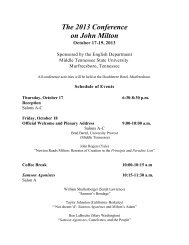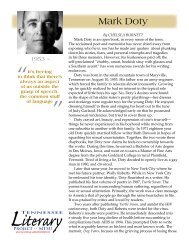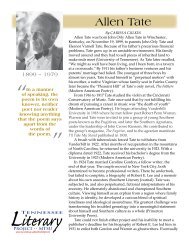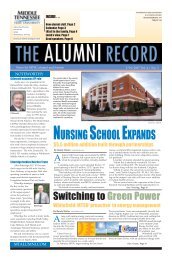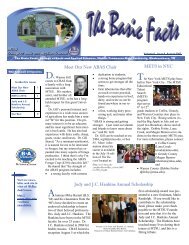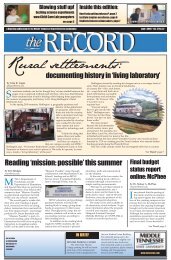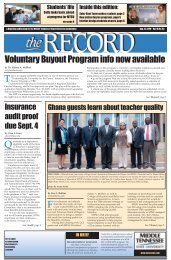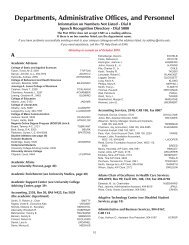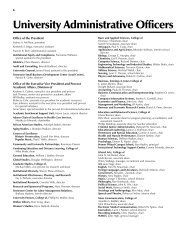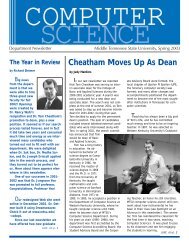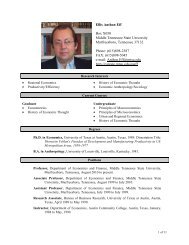f12ch3.pdf
f12ch3.pdf
f12ch3.pdf
You also want an ePaper? Increase the reach of your titles
YUMPU automatically turns print PDFs into web optimized ePapers that Google loves.
1. People who provide you with goods and services<br />
a. are acting out of generosity.<br />
b. do so because they get something in return.<br />
c. have chosen not to become interdependent.<br />
d. are required to do so by the government.<br />
ANS: B DIF: 1 REF: 3-0<br />
2. Regan grows flowers and makes ceramic vases. Jayson also grows flowers and makes ceramic<br />
vases, but Regan is better at producing both goods. In this case, trade could<br />
a. benefit both Jayson and Regan.<br />
b. benefit Jayson, but not Regan.<br />
c. benefit Regan, but not Jayson.<br />
d. benefit neither Jayson nor Regan.<br />
ANS: A DIF: 2 REF: 3-1<br />
3. The production possibilities frontier illustrates<br />
a. the combinations of output that an economy should produce.<br />
b. the combinations of output that an economy should consume.<br />
c. the combinations of output that an economy can produce.<br />
d. All of the above are correct.<br />
ANS: C DIF: 2 REF: 3-1<br />
4. What must be given up to obtain an item is called<br />
a. out-of-pocket cost.<br />
b. comparative worth.<br />
c. opportunity cost.<br />
d. absolute value.<br />
ANS: C DIF: 1 REF: 3-2<br />
5. If Korea is capable of producing either shoes or soccer balls or some combination of the two, then<br />
a. Korea should specialize in the product in which it has an absolute advantage.<br />
b. it would be impossible for Korea to have an absolute advantage over another country in<br />
both products.<br />
c. it would be difficult for Korea to benefit from trade with another country if Korea is<br />
efficient in the production of both goods.<br />
d. Korea’s opportunity cost of shoes is the inverse of its opportunity cost of soccer balls.<br />
ANS: D DIF: 2 REF: 3-2
6. Absolute advantage is found by comparing different producers’<br />
a. opportunity costs.<br />
b. payments to land, labor, and capital.<br />
c. input requirements per unit of output.<br />
d. locational and logistical circumstances.<br />
ANS: C DIF: 2 REF: 3-2<br />
7. Travis can mow a lawn in two hours or he can trim a tree in one hour. Ricardo can mow a lawn in<br />
three hours or he can trim a tree in two hours.<br />
a. Travis has an absolute advantage over Ricardo in trimming trees.<br />
b. Travis has a comparative advantage over Ricardo in mowing lawns.<br />
c. Ricardo has a comparative advantage over Travis in trimming trees.<br />
d. All of the above are correct.<br />
ANS: A DIF: 2 REF: 3-2<br />
8. Belarus has a comparative advantage in the production of linen, but Russia has an absolute<br />
advantage in the production of linen. If these two countries decide to trade,<br />
a. Belarus should export linen to Russia.<br />
b. Russia should export linen to Belarus.<br />
c. trading linen would provide no net advantage to either country.<br />
d. Without additional information about opportunity costs, this question cannot be answered.<br />
ANS: A DIF: 2 REF: 3-3<br />
Table 3-1<br />
Assume that Sardi and Tinaka can switch between producing corn and producing pork at a constant rate.<br />
Minutes Needed to Make 1<br />
Bushel of Corn Pound of Pork<br />
Sardi 20 12<br />
Tinaka 15 10<br />
9. Refer to Table 3-1. Assume that Sardi and Tinaka each has 360 minutes available. If each person<br />
divides his time equally between the production of corn and pork, then total production is<br />
a. 10.5 bushels of corn and 16.5 pounds of pork.<br />
b. 21 bushels of corn and 33 pounds of pork.<br />
c. 35 bushels of corn and 22 pounds of pork.<br />
d. 42 bushels of corn and 66 pounds of pork.<br />
ANS: B DIF: 2 REF: 3-1
10. Refer to Table 3-1. Which of the following combinations of corn and pork could Tinaka not<br />
produce in one 10-hour day?<br />
a. 10 bushels of corn and 45 pounds of pork<br />
b. 20 bushels of corn and 30 pounds of pork<br />
c. 25 bushels of corn and 25 pounds of pork<br />
d. 30 bushels of corn and 15 pounds of pork<br />
ANS: C DIF: 3 REF: 3-1<br />
11. Refer to Table 3-1. What is Tinaka’s opportunity cost of producing one bushel of corn?<br />
a. 2/3 pound of pork<br />
b. 3/4 pound of pork<br />
c. 5/6 pound of pork<br />
d. 3/2 pounds of pork<br />
ANS: D DIF: 2 REF: 3-2<br />
12. Refer to Table 3-1. What is Tinaka’s opportunity cost of producing one pound of pork?<br />
a. 2/3 bushel of corn<br />
b. 3/4 bushel of corn<br />
c. 5/6 bushel of corn<br />
d. 3/2 bushels of corn<br />
ANS: A DIF: 2 REF: 3-2<br />
Table 3-2<br />
Assume that Aruba and Iceland can switch between producing coolers and producing radios at a constant<br />
rate.<br />
Labor Hours<br />
Needed to Make 1<br />
Cooler Radio<br />
Aruba 2 5<br />
Iceland 1 4<br />
13. Refer to Table 3-2. Which of the following represents Aruba's production possibilities frontier<br />
when 100 labor hours are available?<br />
a.<br />
b.<br />
5<br />
4<br />
3<br />
2<br />
1<br />
radios<br />
1 2 3 4 5 coolers
c.<br />
d.<br />
5<br />
4<br />
3<br />
2<br />
1<br />
50<br />
40<br />
30<br />
20<br />
10<br />
500<br />
400<br />
300<br />
200<br />
100<br />
radios<br />
1 2 3 4 5 coolers<br />
radios<br />
10 20 30 40 50 coolers<br />
radios<br />
100 200 300 400 500 coolers<br />
ANS: C DIF: 2 REF: 3-1<br />
14. Refer to Table 3-2. Aruba’s opportunity cost of one cooler is<br />
a. 0.4 radio and Iceland’s opportunity cost of one cooler is 0.25 radio.<br />
b. 0.4 radio and Iceland’s opportunity cost of one cooler is 4 radios.<br />
c. 2.5 radios and Iceland’s opportunity cost of one cooler is 0.25 radio.<br />
d. 2.5 radios and Iceland’s opportunity cost of one cooler is 4 radios.<br />
ANS: A DIF: 2 REF: 3-2<br />
15. Refer to Table 3-2. Suppose Aruba decides to increase its production of radios by 10. What is the<br />
opportunity cost of this decision?<br />
a. 0.25 coolers<br />
b. 2.5 coolers<br />
c. 4 coolers<br />
d. 25 coolers<br />
ANS: D DIF: 2 REF: 3-2
16. Refer to Table 3-2. Aruba should specialize in the production of<br />
a. coolers and Iceland should specialize in the production of radios.<br />
b. radios and Iceland should specialize in the production of coolers.<br />
c. both goods and Iceland should specialize in the production of neither good.<br />
d. neither good and Iceland should specialize in the production of both goods.<br />
ANS: B DIF: 2 REF: 3-2<br />
Figure 3-2<br />
Peru’s Production Possibilities Frontier<br />
400<br />
360<br />
320<br />
280<br />
240<br />
200<br />
160<br />
120<br />
80<br />
40<br />
rubies<br />
1 2 3 4 5 6 7 8 emeralds<br />
17. Refer to Figure 3-2. The fact that the line slopes downward reflects the fact that<br />
a. for Peru, it is more costly to produce emeralds than it is to produce rubies.<br />
b. Peru will produce more emeralds and fewer rubies as time goes by.<br />
c. Peru faces a tradeoff between producing emeralds and producing rubies.<br />
d. Peru should specialize in producing rubies.<br />
ANS: C DIF: 2 REF: 3-1<br />
NAT: Analytic LOC: Understanding and applying economic models<br />
TOP: Production possibilities frontier MSC: Interpretive<br />
18. Which of the following is not a reason people choose to depend on others for goods and services?<br />
a. to improve their lives<br />
b. to allow them to enjoy a greater variety of goods and services<br />
c. to consume more of each good without working any more hours<br />
d. to allow people to produce outside their production possibilities frontiers<br />
ANS: D DIF: 2 REF: 3-1
19. Shannon bakes cookies and Justin grows vegetables. In which of the following cases is it<br />
impossible for both Shannon and Justin to benefit from trade?<br />
a. Shannon does not like vegetables and Justin does not like cookies.<br />
b. Shannon is better than Justin at baking cookies and Justin is better than Shannon at<br />
growing vegetables.<br />
c. Justin is better than Shannon at baking cookies and at growing vegetables.<br />
d. Both Shannon and Justin can benefit from trade in all of the above cases.<br />
ANS: A DIF: 2 REF: 3-1<br />
20. The opportunity cost of an item is<br />
a. the number of hours that one must work in order to buy one unit of the item.<br />
b. what you give up to get that item.<br />
c. always less than the dollar value of the item.<br />
d. always greater than the cost of producing the item.<br />
ANS: B DIF: 1 REF: 3-2



